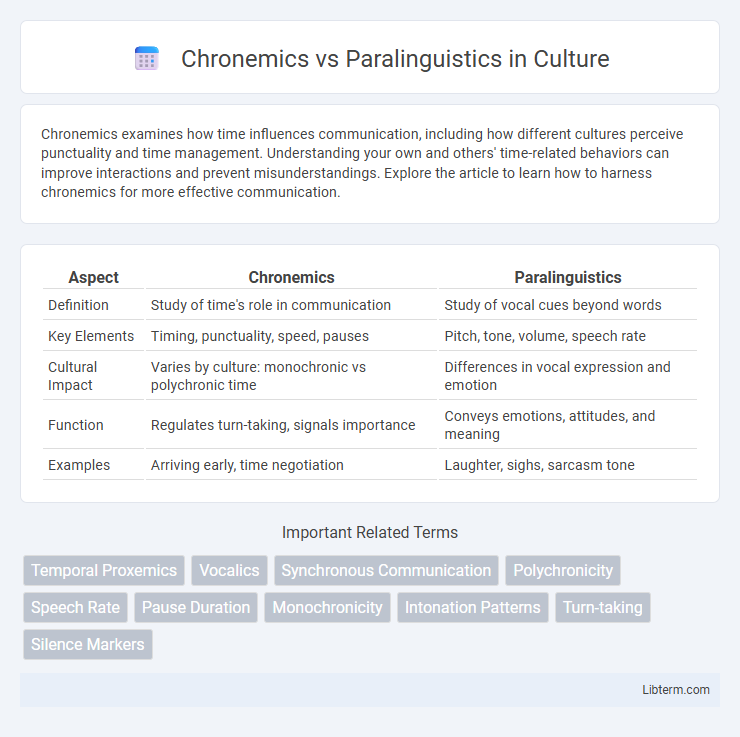Chronemics examines how time influences communication, including how different cultures perceive punctuality and time management. Understanding your own and others' time-related behaviors can improve interactions and prevent misunderstandings. Explore the article to learn how to harness chronemics for more effective communication.
Table of Comparison
| Aspect | Chronemics | Paralinguistics |
|---|---|---|
| Definition | Study of time's role in communication | Study of vocal cues beyond words |
| Key Elements | Timing, punctuality, speed, pauses | Pitch, tone, volume, speech rate |
| Cultural Impact | Varies by culture: monochronic vs polychronic time | Differences in vocal expression and emotion |
| Function | Regulates turn-taking, signals importance | Conveys emotions, attitudes, and meaning |
| Examples | Arriving early, time negotiation | Laughter, sighs, sarcasm tone |
Introduction to Chronemics and Paralinguistics
Chronemics examines how humans perceive and utilize time in communication, including concepts such as punctuality, time orientation, and the pacing of conversations. Paralinguistics focuses on non-verbal vocal elements like tone, pitch, volume, and speech rate that convey meaning beyond words. Both fields are essential for understanding the nuances of interpersonal communication and how messages are interpreted beyond verbal content.
Defining Chronemics: The Language of Time
Chronemics studies how individuals perceive and use time in communication, revealing cultural variations in punctuality, waiting times, and time management. It highlights the role of temporal patterns in conveying nonverbal messages, such as the pace of speech, response latency, and timing of interactions. Understanding chronemics enhances interpretation of social cues and improves interpersonal communication across diverse cultural contexts.
Understanding Paralinguistics: The Power of Vocal Cues
Paralinguistics involves vocal cues such as tone, pitch, volume, and speech rate that convey emotions and intentions beyond the literal meaning of words. These vocal elements play a critical role in communication by influencing how messages are interpreted and enhancing the emotional context. Understanding paralinguistics helps decode subtle signals in conversations, improving interpersonal effectiveness and empathy.
Key Differences Between Chronemics and Paralinguistics
Chronemics examines the role of time in communication, including how individuals perceive and use time in interactions, while paralinguistics involves vocal elements such as tone, pitch, volume, and speech rate that convey meaning beyond words. Chronemics reflects cultural attitudes toward punctuality and waiting, influencing the pace and flow of conversations. Paralinguistics provides emotional context and intonation, shaping the listener's interpretation through vocal nuances.
The Role of Chronemics in Communication
Chronemics significantly influences communication by conveying cultural attitudes, social status, and personality traits through the perception and use of time. Punctuality, waiting time, and the pace of speech serve as nonverbal cues that shape listener interpretations and interaction dynamics. Understanding chronemics enhances clarity and effectiveness in cross-cultural and professional communication contexts.
Paralinguistic Features and Their Meanings
Paralinguistic features include vocal elements such as tone, pitch, volume, and speech rate, which convey emotions and attitudes beyond the literal meaning of words. These non-verbal cues help interpret speaker intent, emphasize messages, and regulate conversational flow, playing a critical role in effective communication. Understanding paralinguistic signals enhances interpersonal interactions by revealing sarcasm, sincerity, urgency, or confusion.
Cultural Variations in Chronemics and Paralinguistics
Cultural variations in chronemics reveal how different societies perceive and manage time, with monochronic cultures valuing punctuality and linear time, while polychronic cultures emphasize flexibility and relational timing. Paralinguistics, encompassing tone, pitch, and speech rate, also varies significantly; for instance, some cultures use louder tones to express enthusiasm, while others consider it disrespectful. Understanding these temporal and vocal communication differences is crucial for effective cross-cultural interaction and minimizing misunderstandings.
Impact of Chronemics on Interpersonal Relationships
Chronemics, the study of time perception and its use in communication, profoundly impacts interpersonal relationships by shaping expectations and interpretations of punctuality, response time, and attention allocation. Variations in cultural time orientations, such as monochronic versus polychronic time use, influence relationship dynamics, trust, and conflict resolution effectiveness. Understanding chronemics helps individuals navigate social interactions more sensitively, enhancing relational satisfaction and reducing misunderstandings related to time management behaviors.
Paralinguistics in Digital Communication
Paralinguistics in digital communication involves the use of vocal elements like tone, pitch, and volume conveyed through audio messages, video calls, and voice notes to express emotions and intentions beyond words. Unlike chronemics, which focuses on time-related cues such as response speed or message timing, paralinguistic cues enrich interaction by adding nuance to digital conversations, enhancing clarity and emotional connection. Emoticons, emojis, and text formatting also serve as paralinguistic tools, compensating for the lack of vocal tone in text-based platforms.
Practical Applications and Implications
Chronemics, the study of time in communication, influences scheduling, punctuality, and task management in professional settings, enhancing efficiency and respect for deadlines. Paralinguistics involves vocal elements like tone, pitch, and volume, crucial for conveying emotions and intent beyond words, improving interpersonal understanding and conflict resolution. Integrating chronemics and paralinguistics facilitates effective communication strategies, optimizing interactions in diverse cultural and organizational environments.
Chronemics Infographic

 libterm.com
libterm.com